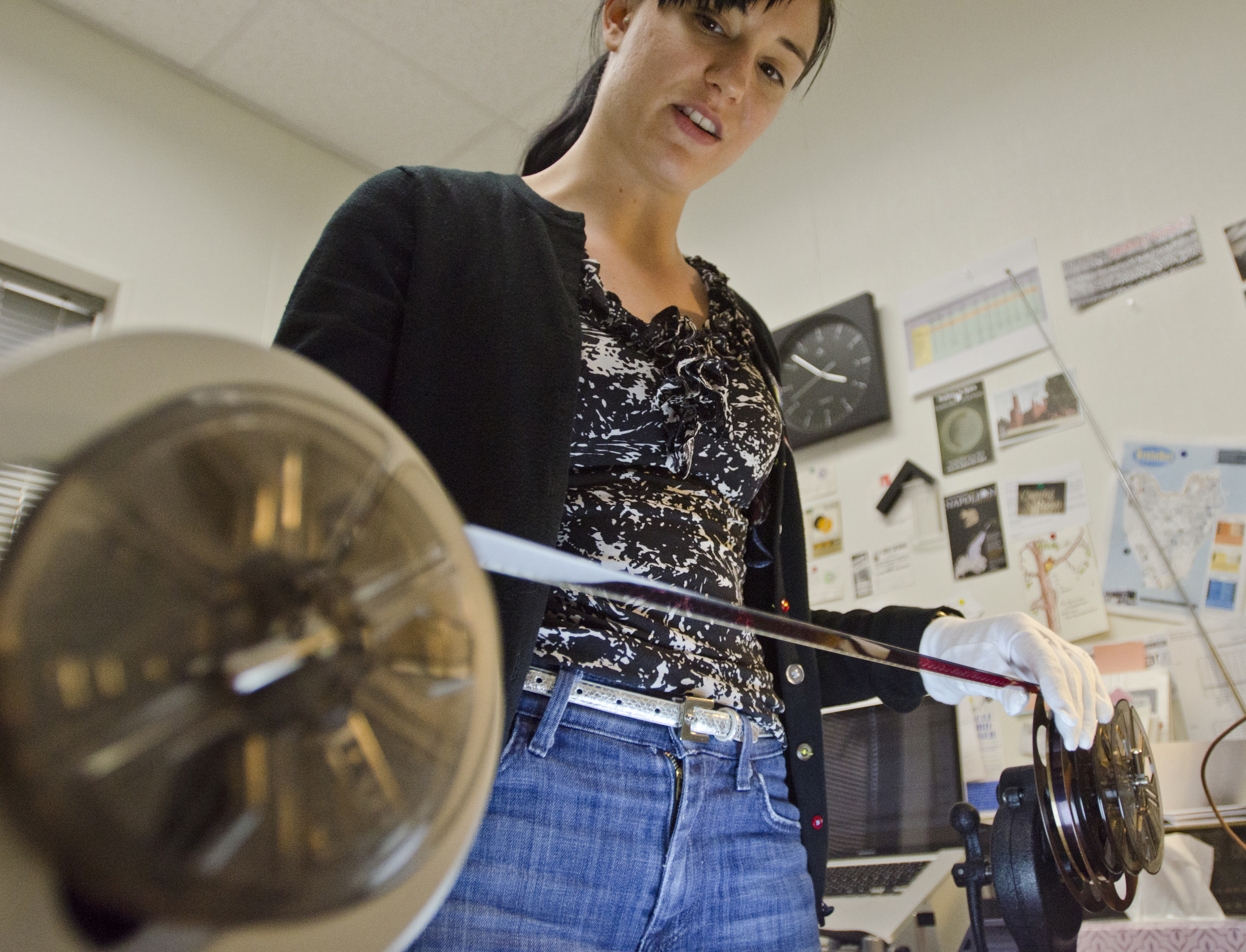UCLA Library preserves audiovisual mementos of the past

Siobhan Hagan works in the UCLA Library’s preservation department as an audiovisual preservation specialist.
By Lynn Chu
July 8, 2012 10:11 a.m.
Correction: The original version of this article contained an error. The UCLA Library Preservation Unit works to gather these mementos of the past, carefully preserving personal letters, photographs, oral history tapes and other items for student research on campus.
From middle school projects and high school love letters to grocery lists and newspaper clippings, records of day-to-day life are found everywhere. But after a short lifespan, these pieces of information disappear into black holes of storage that allow these relics to fade from memory. Strangely, in a world of pack rats and collectors, information still goes missing.
The UCLA Library Preservation Unit works to gather these mementos of the past, carefully preserving personal letters, photographs, oral history tapes and other items for student research on campus. While UCLA has items that reflect world civilizations and span several centuries into the past, the library also takes advantage of the city by gathering materials that specifically reflect the culture and history of Los Angeles.
Recently endowed by the Arcadia Fund, a private funding organization, to institute transformative change within the library, UCLA decided to put this grant toward reformatting and preserving a new medium of the digital age: audiovisual materials.
“It’s been on the minds of everyone because a lot of other large universities are stepping up their game. … (Members of the) film and sound (industries) have been really working the advocacy trail to the library world and not just museums and archives,” said Siobhan Hagan, the audiovisual preservation specialist at the library. “Special collections (here at UCLA) is like a treasure trove of unique AV (audiovisual) materials that would normally be thrown away.”
One of the collections features Vahac Mardirosian, an educator who led a walkout following a 1968 demonstration where Chicano students protested the inequality of the Los Angeles Unified School District.
Susan Anderson, a curator who collects Los Angeles materials for UCLA Library’s special collections, said that Mardirosian was careful to keep leaflets, flyers and original typescripts of his speeches before the board of education and meeting minutes for the organization he headed.
Anderson said that major events and what the famous accomplished can easily be found through government archives and history textbooks; it’s the routine materials that are actually more important.
“It’s the dailyness of life. How did people live within their families? What were their concerns?” Anderson said. “These materials that we preserve help us understand the past beyond the official record.”
The Aldous Huxley Papers, a collection of the late English writer’s works, has more than 700 audio and visual recordings from special collections.
Genie Guerard, manuscript librarian for the Charles E. Young Research Library Department of Special Collections, said that among these recordings are interviews, lectures and speeches at various times and places, poetry readings and even recordings of sessions where he and others were experimenting with psychedelics.
“People who (access these) materials can hear the tone of voice, the speed and way of speech,” Guerard said. “That sort of information might be information that doesn’t exist in any other form.”
With curating mainly focused on collecting these personal and everyday items, the UCLA Library has come across several materials that have become entirely unique to the university’s special collections.
Anderson says these audiovisual collections capture a beauty and essence of Los Angeles history with items that most other universities can’t lay claim to.
Phyllis Diller, who was the one of the first famous female stand-up comedians and also a longtime resident of Los Angeles, has a collection containing rare footage of her work that was acquired by the UCLA Library.
The UCLA Library also holds an extensive audiovisual collection of the Synanon organization, which started out in Los Angeles as an Alcoholics and Narcotics Anonymous for the wealthy upper-class in the 1950s.
Synanon produced films and tapes of their unauthorized group sessions before going through a series of court proceedings for alleged criminal activity.
Years later, these AV materials proved critical to many medical clinics and student researchers that wanted to study the therapeutic drug addiction treatments Synanon pioneered.
Whether it be collections about comedians and public figures who lived in Los Angeles, or political histories and social justice movements, the library holds a story for many of them. But it’s not just about the information of the past ”“ it’s also about the AV materials people are creating today.
“A lot of people don’t realize that the newer (material) has an even shorter lifespan than the vast majority of the older material. It’s not going to last forever,” Hagan said. “(Everyone could) back up files and look into personal digital archiving. (The one thing) we can’t do with digital data is store and ignore.”

